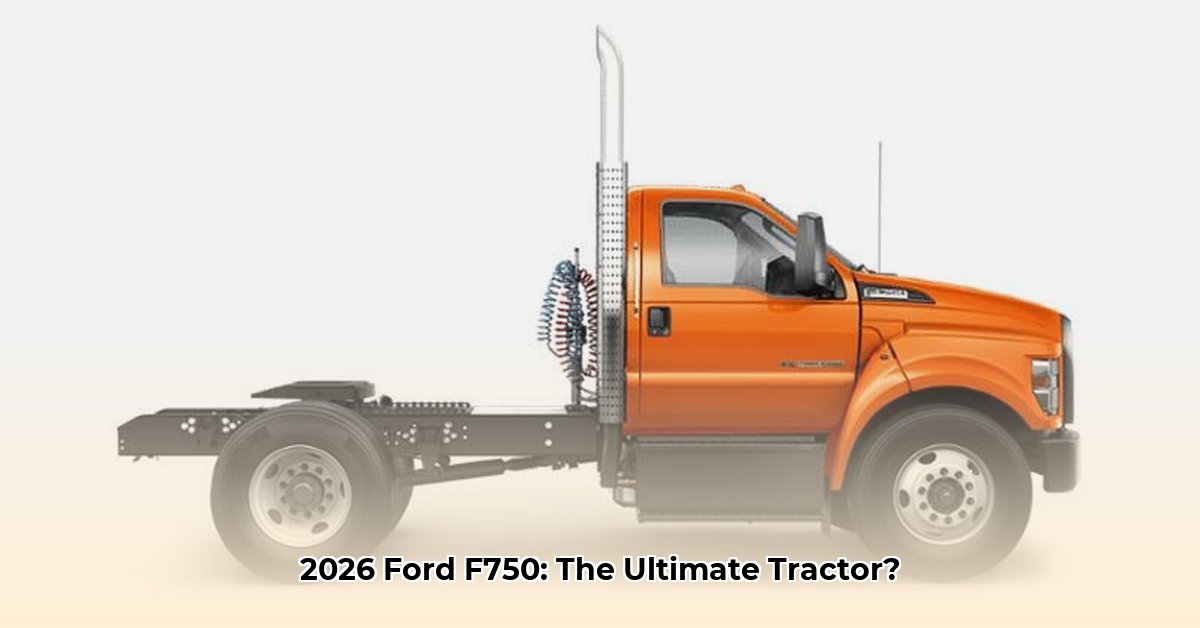
This comprehensive review delves into the 2026 Ford F-750, examining its performance capabilities, safety features, real-world applications, upfitting considerations, and total cost of ownership (TCO) to provide a thorough assessment of its suitability for various heavy-duty hauling needs. We'll also compare it directly to key competitors. For more detailed specifications, see the F-750 tractor specs.
Powertrain Performance: Engine and Transmission Options
The F-750 offers a choice of powertrains designed to meet diverse operational requirements. The 7.3L V8 gasoline engine provides ample power for lighter-duty applications, offering a balance of performance and simpler maintenance. However, for heavier hauling tasks demanding superior torque and fuel efficiency over extended periods, the 6.7L Power Stroke diesel engine is the clear choice. This engine has demonstrated impressive torque in simulations, but real-world fuel economy data under varying load conditions is crucial for a comprehensive analysis and remains pending further independent testing and user feedback.
Paired with either engine is Ford's TorqShift heavy-duty automatic transmission. Featuring modes like Tow/Haul, this transmission enhances drivability and safety, especially when towing heavy loads. The inclusion of a live-drive power take-off (PTO) further extends the F-750's versatility, accommodating a wide range of specialized equipment. However, the actual fuel consumption in various real-world scenarios, including terrains and driving styles, requires further investigation to accurately reflect its true fuel efficiency. This will be a key aspect in the total cost of ownership comparison.
Safety and Driver-Assist Technologies
Safety is paramount in heavy-duty trucking. The F-750 addresses this with the optional Co-Pilot360 suite of driver-assist technologies. This offers features like automatic emergency braking (AEB), lane-keeping assist, and adaptive cruise control (available on air brake models). These features can significantly mitigate risks and reduce driver fatigue on long hauls. However, evaluating the long-term reliability and cost of maintenance and potential upgrades for these systems is crucial for a complete picture of the TCO. How will these systems perform over many years of operation? What are the potential repair and replacement costs?
Real-World Performance and Applications
To accurately assess the F-750's capabilities, real-world performance data is essential. More data is needed to fully understand fuel efficiency under various load and environmental conditions. User reviews and independent testing results will provide invaluable insights into its performance in diverse hauling scenarios. Specifically, we need further data on its performance with heavy loads on steep inclines, fuel consumption in stop-and-go city traffic, and its ability to handle challenging weather conditions such as snow, ice, or extreme heat. These factors directly influence its practical utility and overall value.
Upfitting Considerations: Customization and Costs
Customizing the F-750 through upfitting significantly enhances its functionality, allowing for precise tailoring to individual operational needs. While Ford promotes the ease of upfitting, the true cost and complexity can vary significantly depending on the specific modifications chosen. A comprehensive cost analysis for various upfitting options is therefore vital, including an examination of the Vehicle Integration System 1.0. Potential hidden costs and unexpected expenses should also be considered along with a comparison to competitor trucks' upfitting processes.
Total Cost of Ownership (TCO) Analysis
A comprehensive TCO analysis is crucial for evaluating the long-term financial implications of owning an F-750. This involves a thorough examination of fuel consumption, maintenance expenses, and projected resale value. Crucially, how does the F-750’s projected TCO compare to equivalent models from Freightliner, International, and Kenworth?
Competitive Comparison: Key Competitors
A direct comparison with leading competitors like Freightliner, International, and Kenworth is vital for assessing the F-750's position in the market. While a preliminary comparison table is provided below, comprehensive data is required for a conclusive assessment. Further research is needed to complete this.
| Feature | Ford F-750 | Freightliner | International | Kenworth |
|---|---|---|---|---|
| Engine Options | 7.3L Gas, 6.7L Diesel | Multiple options | Multiple options | Multiple options |
| Payload Capacity | To be determined | To be determined | To be determined | To be determined |
| Driver Assists | Co-Pilot360 | Varies | Varies | Varies |
| Upfittability | To be determined | To be determined | To be determined | To be determined |
| Estimated TCO | To be determined | To be determined | To be determined | To be determined |
Conclusion: Awaiting Further Data
While the Ford F-750 presents significant potential with its powerful engine options and advanced safety features, a definitive conclusion on its value and competitiveness requires more data. Further research into real-world fuel economy, a detailed upfitting cost analysis, and a robust head-to-head comparison against key competitors are essential to complete this review. This analysis provides a foundation for future, more conclusive assessments.